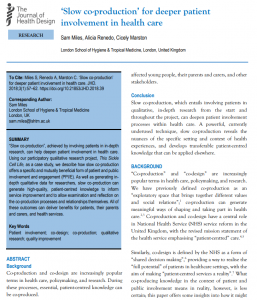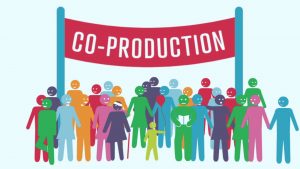
Our article, ‘Slow co-production’ for deeper patient involvement in health care’, has just been published in the Journal of Health Design. It’s open access so anyone can read it, download it and share it. The article argues that ‘slow co-production’, achieved by involving patients in in-depth research, can help deepen patient involvement in health care. We describe how slow co-production offers a mutually beneficial form of patient and public involvement. It promotes patient-centered knowledge and helps us to examine and reflect on the co-production processes themselves, rather than always rushing to evaluate the end product as if it came into being without a process and a series of human relationships.
The thinking behind this article was our different and shared experiences of time constraints in qualitative fieldwork. We discussed, for example, those times when we felt pressured to move on from fieldwork when we didn’t feel we had been able to fully examine the narratives that we were learning about, or the interviews we were conducting. This restriction to fieldwork research is usually required for budget and time constraints, but it can feel frustrating to have to withdraw from the work being conducted when it feels like there is more to be gained.
More positively, we recognise that we have also experienced opportunities for more thorough, in-depth ‘slow’ research, including the Sickle Cell project that this new article takes as its case study. We believe that this kind of ‘slow’ research, as previously explored in healthcare research by Vincanne Adams et. al (2013) and Heather Mendick (2014) amongst others, is an important antidote to the ever-building pressures that are heaped upon the researcher. To make things yet more complicated, these pressures come from a range of different external sources: for example, a rush to complete fieldwork within a limited timeframe to minimise costs for the funding body, or unexpected delays in participant recruitment that mean that tightly organised fieldwork cannot extend beyond the ethical clearance period granted by the host organisation.
This idea of ‘slow’ working isn’t new (see, for example, Honoré, 2005, or ‘A Call for Slow Scholarship’ by Hartman and Darab, 2012), but it is worth repeating: so much of academic research is subject to the restrictions of budget, outcome, time constraints and metrics that need ticking off that we forget how valuable time and space are for germinating our best ideas. The useful analytical frameworks, or new theories, or vital links we make between seemingly unrelated sets of results are often produced in the scarce time we get to think deeply about concepts or theories at length. It is this type of time which has become most compressed in the contemporary neoliberal university, where there are so many competing demands on the researcher’s time and attention, from emails to admin to marking to service.
In our discussions we came to a consensus that for us, ‘slow’ co-production is about having time to genuinely engage with others in dialogues that cover more ground than simply sharing ideas, although of course ideas come from dialogue so the two concepts aren’t separate. As well as sharing ideas, we can think of slow co-production in terms of humanity and human rights: specifically, reducing the gap between the researcher and the researched, and trying to find common ground in a qualitative methodology that productively disrupts some of the traditional boundaries that we have seen replicated over and over across social sciences and public health research. Therefore, as well as the point that taking more time in the research field can develop more positive, meaningful relations between the different parties in the research, we also want to stress that this in-depth, detailed, sensitive approach to interviewing is a specific form of co-production, and one that we want to pursue further across our DEPTH projects.
So, whilst our article is primarily arguing for the importance of involving patients and participants in qualitative research from the start and throughout the lifespan of a research project, we hope it also offers a small insight into the opportunities enabled by ‘slow’, thorough working between researchers and participants. This ‘slow’ process – scarce as it sometimes feels the opportunity is – can offer a really valuable way into mutually beneficial collaboration.

References
Adams V, Burke NJ, Whitmarsh I. (2014) Slow Research: Thoughts for a Movement in Global Health. Medical Anthropology, 33(3): 179-97. https://doi.org/10.1080/01459740.2013.858335
Hartman Y, Darab, S. (2012) A Call for Slow Scholarship: A Case Study on the Intensification of Academic Life and Its Implications for Pedagogy. Review of Education, Pedagogy, and Cultural Studies, 34(1): 49-60. https://doi.org/10.1080/10714413.2012.643740
Honoré C. (2005) In Praise of Slowness: Challenging the Cult of Speed. New York: HarperCollins.
Mendick H. (2014) Social class, gender and the pace of academic life: What kind of solution is slow? Forum: Qualitative Social Research, 15(3):7. http://nbn-resolving.de/urn:nbn:de:0114-fqs140374.
